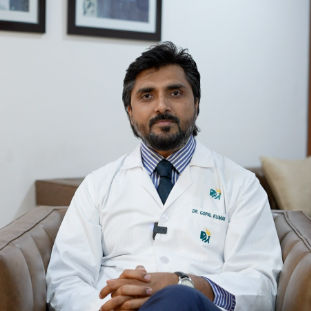Can Hemangioma Become Cancerous
Get a comprehensive overview of the common types of hemangiomas, their causes, symptoms, detection methods, cancer risk, complications, treatment options, and outcomes. Discover follow-up care and ways of managing complications.

Written by Dr Sonia Bhatt
Last updated on 3rd Jul, 2025
Can Hemangioma Become Cancerous: Common Types, Causes, Cancer Risk & More
Hemangiomas are benign tumours that occur when blood vessels group together in an unusual manner. They are the most prevalent type of birthmark, characterised by their bright red colour. Hemangiomas develop shortly after birth, often within the first few weeks. They can develop anywhere on the body but are most widespread on the head, face, scalp, chest, and back region. Despite their aggressive progress, hemangiomas are not typically dangerous and tend to regress during the early years of children’s lives.
This guide will discuss the various causes, signs, management, relevant treatment, and follow-up care methods to aid parents and patients.
Understanding the Common Types of Hemangiomas
Capillary hemangiomas affect the skin's outer layers and manifest in two primary forms:
Infantile hemangiomas, involving up to 12% of newborns, are benign tumours that disappear during childhood.
Cherry hemangiomas, existing in adults as small red papules, are often formed in groups and not associated with underlying structural abnormality.Cavernous hemangiomas affecting the deeper dermal layers are more clinically relevant when they arise near the eyes because they affect vision. This deeper infiltration grows actively as dark red to blue tumours. It should be kept under check due to the likelihood of complications that interfere with vision, such as amblyopia, glaucoma, or even cataracts.
Hemangiomas and Cancer Risk
Here is an overview of hemangiomas and their risk of developing cancer:
Hemangiomas are benign raised growths of extra blood vessels that cannot develop into cancer.
Most hemangiomas fade away—50% are gone within 5 years, and nearly all within 9 years.
Liver hemangiomas, which may sound threatening when diagnosed, remain benign and often require no intervention.
Muscle or bone growths that are large or invasive or that interfere with vital body functions such as vision, breathing, or eating
may need to be removed surgically.
Causes and Risk Factors of Hemangiomas
Listed below are the common causes of hemangiomas:
Doctors do not fully understand the exact cause of hemangiomas, which occur when blood vessels develop abnormally.
Many factors during pregnancy may cause them, including bleeding in the early stages or high blood pressure.
Fertility treatments, hormone medications, certain surgeries, and other processes may also be involved.
Although these growths are often hereditary, no specific gene exists for such cancers.
Hemangiomas are commonly found in premature caucasian female babies. In adults, women between 30-50 years are at high risk of developing liver hemangiomas, especially after childbirth or use of hormonal drugs. They are also found to be more common in women compared to men.
Hemangiomas: Symptoms and Detection
These benign vascular growths can appear on the skin or develop internally, causing a range of symptoms depending on their location.
Skin hemangiomas appear cherry-like red or black-brown, which may be flat or slightly raised.
They begin as small red spots and may expand into even bigger blotches as time passes.
When inside the body, they can cause different problems.
Some stomach hemangiomas may contribute to nausea, vomiting, or stomach ache.
Those in the liver would make individuals feel more full than usual or make them feel less hungry.
Diagnostic Procedures for Hemangiomas
Skin hemangiomas are easily visible, and doctors can identify them by observing them casually during a physical examination. They also use special techniques, such as ultrasound, Magnetic Resonance Imaging (MRI), or Computed Tomography (CT) scans, to look for growth inside the body.
Sometimes, these vascular malformations can be moderate and become known to a doctor when the patient is examined for other illnesses.
Hemangiomas Treatment Options
The treatment options for hemangiomas are:
Since most hemangiomas do not require treatment and gradually disappear independently, practitioners usually prescribe noninvasive methods for managing them.
Doctors usually prescribe topical gels and creams, such as timolol, for skin growth, ingesting liquid medication (propranolol), or undergoing laser therapy, which reduces the size of the protuberance.
At times, doctors use both treatments at the same time for persistent lesions.
Surgery is required only when hemangiomas interfere with vision, breathing, or any other function of the human body.
Consult Top Doctors for Personalised Treatment
Monitoring Hemangiomas Cases
Since hemangiomas grow most actively during the first year of life, it is essential to visit a doctor regularly:
During such visits, doctors will take photos, assess the tumour's growth, and look for signs, such as bleeding and pain, that contribute to it.
In the case of hemangiomas located in deeper tissues, doctors may perform various scans, such as ultrasounds, to monitor the size and position.
Follow-up Care for Hemangiomas
The follow-up care for hemangiomas includes:
Protecting the area from abrasions and accidental injuries.
Applying sunscreen on the exposed hemangiomas to avert irritation from sunlight.
Keenly observing signs indicating it might be time to see the doctor, such as bleeding, pain, and alarming growth.
Consulting a healthcare provider about walking/running and other activities that pose a risk, especially for internal hemangiomas.
Documenting any change in visible hemangiomas by taking regular pictures.
Complications Associated with Hemangiomas
Some of the potential complications associated with hemangiomas are:
The foremost disadvantage of leaving hemangiomas untreated is that they cause several issues, all of which depend on the part of the body affected.
Skin hemangiomas may form ulcers that can readily become infected. When they come into contact with the eyes, they can cause eye problems or harm the optic nerve.
Large liver hemangiomas can pressure the heart, and hemangiomas that develop in the ear canal are likely to cause hearing problems.
Prognosis for Patients with Hemangiomas
The overall prognosis of hemangioma patients is favourable because these formations usually regress and may disappear independently. Primarily initiated at 12-18 months, most hemangiomas are gone by age 10. The remaining marks are sometimes few and do not affect the person’s health.
Several key factors affect how well hemangiomas resolve:
Location and type of growth
When and in what circumstances the treatment commences
Initial response to the first line of treatment
The patient’s overall health and stability
Age when the hemangioma was first noted
Myths and Facts about Hemangiomas
Most of the myths about hemangiomas are pretty unhelpful and contribute to the excess of anxiety. People often wrongly believe that:
Hemangiomas in babies are the results of either mother’s diet or stress during her pregnancy.
These growths are communicable from one human being to the other.
Each hemangioma requires medical therapy.
They can progress to cancer, especially in later stages of life.
The truth about hemangiomas is much more reassuring:
They are usually benign and normal skin findings that develop in approximately 10% of infants.
Most shrink and fade are asymptomatic and would not require treatments anyway.
They go through three stages: increase, solidity, and diminishment
They develop during the early developmental stage, though doctors have not explained the reason accurately.
They can be found virtually anywhere on the body, but the head, neck, and chest are common sites.
They are not related to anything a mother does throughout her pregnancy.
Conclusion
Even though they might appear intimidating, most hemangiomas pose no threat and eventually fade away on their own. In many cases, patients with hemangiomas are likely to have an excellent prognosis through appropriate follow-up and prompt management when necessary. It is always essential to seek advice and treatment from health practitioners when these developments impact vital functions or cause discomfort.
Consult Top Oncologists
Consult Top Doctors for Personalised Treatment

Dr Sunita Samleti
Oncologist
18 Years • M.D. (Pathology)- TN Medical College, Mumbai University, Mumbai, Mar 2005 M.B.B.S. Grant Medical College, Mumbai University, Mumbai, Oct 1999
Chinagadila
Apollo Hospitals Health City Unit, Chinagadila

Dr. Sanchayan Mandal
Medical Oncologist
17 Years • MBBS, DNB Raditherapy, DrNB Medical Oncology
East Midnapore
VIVEKANANDA SEBA SADAN, East Midnapore

Dr.sanchayan Mandal
Medical Oncologist
17 Years • MBBS, DrNB( MEDICAL ONCOLOGY), DNB (RADIOTHERAPY),ECMO. PDCR. ASCO
Kolkata
Dr. Sanchayan Mandal Oncology Clinic, Kolkata

Dr Gowshikk Rajkumar
Oncologist
10 Years • MBBS, DMRT, DNB in Radiation oncology
Bengaluru
Apollo Clinic, JP nagar, Bengaluru

Dr. Gopal Kumar
Head, Neck and Thyroid Cancer Surgeon
15 Years • MBBS, MS , FARHNS ( Seoul, South Korea ), FGOLF ( MSKCC, New York )
Delhi
Apollo Hospitals Indraprastha, Delhi
(25+ Patients)
Consult Top Oncologists

Dr Sunita Samleti
Oncologist
18 Years • M.D. (Pathology)- TN Medical College, Mumbai University, Mumbai, Mar 2005 M.B.B.S. Grant Medical College, Mumbai University, Mumbai, Oct 1999
Chinagadila
Apollo Hospitals Health City Unit, Chinagadila

Dr. Sanchayan Mandal
Medical Oncologist
17 Years • MBBS, DNB Raditherapy, DrNB Medical Oncology
East Midnapore
VIVEKANANDA SEBA SADAN, East Midnapore

Dr.sanchayan Mandal
Medical Oncologist
17 Years • MBBS, DrNB( MEDICAL ONCOLOGY), DNB (RADIOTHERAPY),ECMO. PDCR. ASCO
Kolkata
Dr. Sanchayan Mandal Oncology Clinic, Kolkata

Dr Gowshikk Rajkumar
Oncologist
10 Years • MBBS, DMRT, DNB in Radiation oncology
Bengaluru
Apollo Clinic, JP nagar, Bengaluru

Dr. Gopal Kumar
Head, Neck and Thyroid Cancer Surgeon
15 Years • MBBS, MS , FARHNS ( Seoul, South Korea ), FGOLF ( MSKCC, New York )
Delhi
Apollo Hospitals Indraprastha, Delhi
(25+ Patients)


